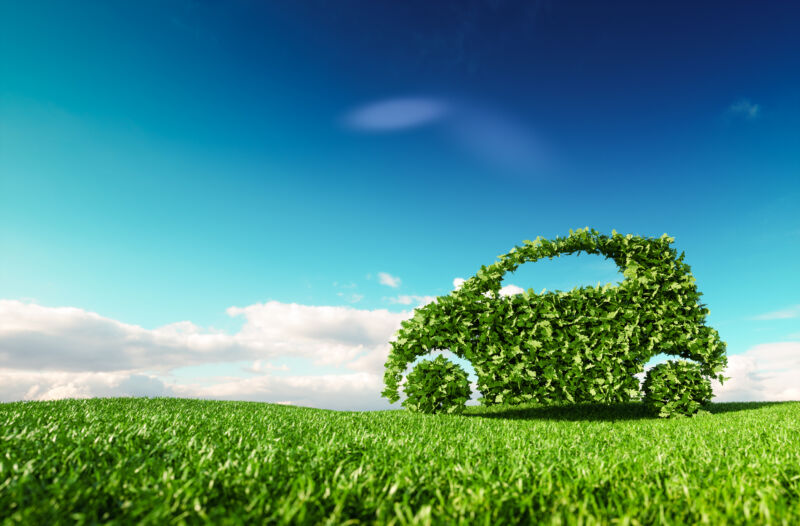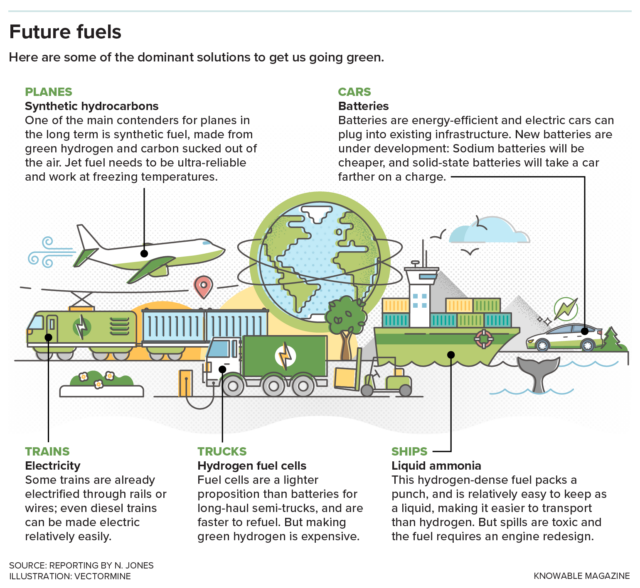
As the world races to decarbonize everything from the electricity grid to industry, it faces particular problems with transportation—which alone is responsible for about a quarter of our planet’s energy-related greenhouse gas emissions. The fuels for transport need to be not just green, cheap, and powerful, but also lightweight and safe enough to be carried around.
Fossil fuels—mainly gasoline and diesel—have been extraordinarily effective at powering a diverse range of mobile machines. Since the Industrial Revolution, humanity has perfected the art of dredging these up, refining them, distributing them and combusting them in engines, creating a vast and hard-to-budge industry. Now we have to step away from fossil fuels, and the world is finding no one-size-fits-all replacement.
Each type of transportation has its own peculiarities—which is one reason we have different formulations of hydrocarbons today, from gasoline to diesel, bunker fuel to jet fuel. Cars need a convenient, lightweight power source; container ships need enough oomph to last months; planes absolutely need to be reliable and to work at subzero temperatures. As the fossil fuels are phased out, the transport fuel landscape is “getting more diverse,” says Timothy Lipman, co-director of the Transportation Sustainability Research Center at the University of California, Berkeley.
Every energy solution has its pros and cons. Batteries are efficient but struggle with their weight. Hydrogen—the lightest element in the universe—packs a huge energy punch, but it’s expensive to make in a “green” way and, as a gas, it takes up a lot of space. Liquid fuels that carry hydrogen can be easier to transport or drop into an existing engine, but ammonia is toxic, biofuels are in short supply, and synthetic hydrocarbons are hard to produce.
The scale of this energy transition is massive, and the amount of renewable energy the world will require to make the needed electricity and alternative fuels is “a little bit mind-blowing,” says mechanical engineer Keith Wipke, manager of the fuel cell and hydrogen technologies program at the National Renewable Energy Laboratory in Colorado. Everything, from the electrical grid to buildings and industry, is also thirsty for renewable power: It’s estimated that overall, the global demand for electricity could more than double by 2050. Fortunately, analyses suggest that renewables are up to the task. “We need our foot on the accelerator pedal of renewables 100 percent, as fast as we can, and it will all get used,” says Wipke.

In order to stay below 1.5° of planetary warming and limit some of the worst effects of climate change, the Intergovernmental Panel on Climate Change recommends that the world hit net-zero emissions by 2050—meaning that whatever greenhouse gases we still put into the air we take out in other ways, such as through forests or carbon capture. Groups including the International Energy Agency (IEA)—a Paris-based intergovernmental organization that analyzes the global energy sector—have laid out pathways that can get the world to net zero.
The IEA’s pathway describes a massive, hard-to-enact shift across the entire world, including all kinds of transport. Their goal: to replace fossil fuels (which release long-captured carbon into the air, where it wreaks havoc on the climate) with something more sustainable, like green hydrogen or biofuels (which either don’t produce greenhouse gases at all or recycle the ones that are already in the air).
Although some transportation sectors are still in flux, we can now get a pretty good glimpse of what will likely be powering the ships, planes, trains, and automobiles of tomorrow. Here’s a peek into that future.


















+ There are no comments
Add yours